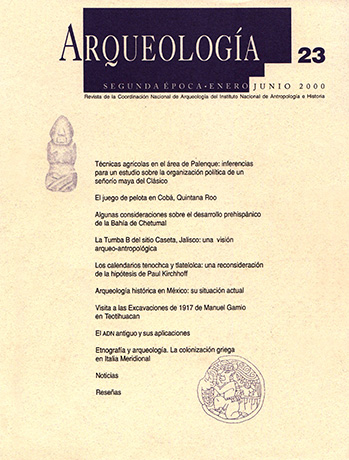Artículos
Técnicas agrícolas en el área de Palenque: inferencias para un estudio sobre la organización política de un señorío maya del Clásico
Publicado 2018-06-04
Cómo citar
Técnicas agrícolas en el área de Palenque: inferencias para un estudio sobre la organización política de un señorío maya del Clásico. (2018). Arqueología, 23, 3-25. https://revistas.inah.gob.mx/index.php/arqueologia/article/view/12143
Resumen
Sin resumenDescargas
Los datos de descarga todavía no están disponibles.
Referencias
- Adams, Richard E. W.
- The Collapse of Maya Civilization, Austin, University of Texas Press.
- Arnold, J. E. y A. Ford
- “A Statistical examination of settlement patterns of Tikal, Guatemala”, en American Antiquity, 45, pp. 713-726.
- Berlín, Heinrich
- 956. ''Archaeological reconnaissance in Tabasco'', en Current Reports, núm. 7, Washington D.C., Carnegie Institution of Washington.
- Bishop, R. L.
- '”Pre-columbian pottery: research in the Maya region “, en Archaeometry of Pre-Columbian sites and Artifacts, Los Angeles, The Getty Conservation Institute, D. A. Scott y P. Meyers (eds.), pp. 15-65
- Blanton, R. et al.
- Ancient Mesoamerica. A Comparison of Change in Three Regions, Cambridge, Cambridge University Press.
- Blom, Franz
- Las Ruinas de Palenque, Xupa y Finca Encanto, México, D. F., INAH, 3a. ed., 1991.
- Blom, Franz y Oliver La Farge
- Tribes and Temples. A Record of the Expedition to Middle America Conducted by the Tulane University of Luisiana, Nueva Orléans, Tulane University.
- Brumfiel, Elizabeth y John W. Fox (eds.)
- Factional Competition and the Political Developmentin the New World, Cambridge, Cambridge University Press.
- Cogwill, George
- “On causes and consequences of ancient and modern population changes”, en American Anthropologist, núm. 77, pp. 505-525.
- Sanders, William T. y D. L.Webster
- “Unilinealism, multilinealism, and The evolution of complex society”, en C. L. Redman, M. J. Berman, E. V. Curti.n, W. T. Langhorn , Jr., N. M. Versaggi y J. C. Wanser (eds.), Social Archaeology: Beyond Subsistence and Dating, Nueva York, Academic Press, pp. 249-302.
- Sanders, William T. y C. N. Murdy
- “Cultural evolution and ecological succession in the valley of Guatemala: 1500 B. C.-A. D. 1524'', en Kent V. Flannery (ed ), Maya Subsistence. Studies in Memory of Dennis E., Puleston, Nueva York, Academic Press, pp. 19-64.
- Scarborough, Vernon L.
- “Water management adaptations in non-industrial complex societies: an archaeological perspective”, en Michael Schiffer (ed.), Archaeological Method and Theory, vol. 3, The University of Arizona Press, Tucson, pp. 101-145
- “Water managernent in the southern Maya lowlands: an accretive model for the engineered landscape”, en Vernon L. Scarborough y B.. L. Isaac (eds.), Economic Aspects of Water Management in the Prehispanic New World, Greenwich, Research in Economic Anthropology, Supplement 7, JAI Press, pp. 17-70.
- Schele, Linda
- a. “Architectural development and political history, at Palenque”, en Elizabeth P. Benson(ed.), City-States of the Maya: Art and Architecture, Denver, Rocky Mountain Institute for PreColumbian Studies, pp. 110-138.
- “An epigraphic history of the western maya region”, en T. Patrick Culbert (ed.), Classic Maya Polítical History. Hieroglyphic and Archaeological Evidence, Cambridge, SAR, Cambridge University Press, pp.72-1O1.

